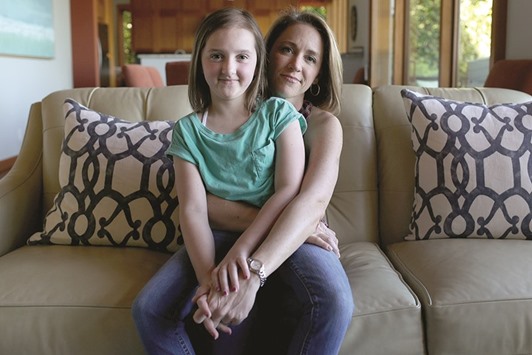When doctors at Seattle Children’s wanted to try an experimental treatment to attack preschooler Katie Belle’s rare and dangerous cancer, her parents were willing but wary.
The Seattle girl was diagnosed at 3 ½ with high-risk neuroblastoma, a nerve-cell disease that triggers tumours in babies and young children — and leads to death in more than half within five years. Katie’s chances of survival were even lower — just 35 percent.
Surgery had already removed a baseball-sized tumour from the child’s stomach, and scans showed the cancer had spread.
“She was classified as stage 4, high-risk,” recalled Katie’s mom, Jennifer Belle, 46, of Seattle. “This is the throw-the-book-at-it approach.”
Dr Julie Park, the pediatric oncologist treating Katie, thought the girl was a prime candidate for a new but unproven therapy: using two transplants of a patient’s own stem cells — not just one — to wipe out the deadly cancer cells.
Two transplants meant even more chemotherapy, high doses of toxic drugs with brutal short- and long-term side effects. But if it worked, the double dose could save Katie — and other kids like her, Park said.
Turns out, she was right.
Six years after her second transplant, Katie is an active third-grader with no signs of disease. And the protocol developed by Park and her colleagues in the Children’s Oncology Group has been adopted as the new standard of care for kids with neuroblastoma across North America.
“I’m very happy Katie was in the trial and super-happy that the results show that there are better ways to treat kids and have them live longer,” said Belle.
Years of research
The trial, led by Park in cooperation with pediatric cancer experts across the US, enrolled 652 patients with high-risk neuroblastoma between 2007 and 2012. It included 355 children who were randomly placed in groups that received either one stem-cell transplant or two, along with high doses of chemotherapy.
Three years after treatment, about 61 percent of the patients who received a double transplant were alive and free of cancer, compared with about 49 percent of those who received just one transplant.
Park, who is also a professor of pediatrics at the University of Washington, is scheduled to present the results of the clinical trial Sunday in Chicago at the annual meeting of the American Society of Clinical Oncology (ASCO).
The work is one of five abstracts selected from more than 5,000 and deemed to have the greatest potential to impact patient care, ASCO officials said.
“It’s really a big game-changer,” said Dr Scott Baker, director of the pediatric bone-marrow transplant program at Seattle Children’s and the Fred Hutchinson Cancer Research Center. He was not involved with the study. “It’s already sort of immediately taking effect.”
Work on the double-transplant protocol was years in the making, Park said. Research dates to the 1990s, when scientists first found that stem-cell transplants improved survival better than chemotherapy alone against neuroblastoma and other cancers.
For about 15 years, single stem-cell transplants have been the standard of care in the US.
The transplants work by removing a patient’s own stem cells from the blood, blasting the patient with intense chemotherapy or radiation to kill the cancer, then returning the collected cells back to the body.
By about 2000, doctors had found it was possible to collect enough stem cells from a small child to perform two transplants, Park said.
Neuroblastoma is diagnosed in about 700 children a year in the US, including about 350 with high-risk cases such as Katie’s.
It occurs most often in children younger than 6; the median age in Park’s study was 3.
“It’s been a long time,” said Park, 54. “I like to talk about how my children were toddlers when we started this and now they’re in college.”
Toll of treatment
The double transplant works better because it allows additional doses of intensive chemotherapy, but the cure comes at a cost, Park said.
In Katie’s case, the chemotherapy left her with hearing loss, an underactive thyroid, weak roots in her permanent teeth and stunted growth. She’ll be infertile as an adult and is at risk for heart problems, leukemia and the possible return of the neuroblastoma.
“It is evident that this is just poison,” said Belle. “You treat a 3-year-old with two transplants, those organs have a long way to go.”
Belle and her husband, Jeff Belle, 44, vice president of publishing at Amazon, have created a fund in Katie’s name for neuroblastoma research.
So far, it’s raised nearly $500,000.
But at age 10, Katie is flourishing, said Belle, who also has a son, Tommy, 8. Katie enjoys school at Seattle’s Villa Academy and she’s on a swim team.
“She remembers none of this,” Belle said.
Park is turning attention now to research that focuses not only on keeping kids alive, but reducing the toll of treatment.
“The regime we give for high-risk neuroblastoma is the most aggressive and toxic that we give children with cancer, or anybody with cancer,” she said. “The next step is to develop newer, less-toxic therapies.” —The Seattle Times/TNS

MUM’S THE WORD: Jen Belle and her daughter, Katie, 10, pose for a portrait in the living room of their home in Seattle. Katie underwent a clinical trial for neuroblastoma, a form of cancer.
